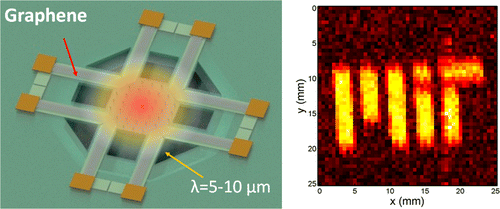Movies such as 1987's "Predator," in which an alien who sees in the infrared hunts down Arnold Schwarzenegger and his team, introduced a generation of sci-fi fans to thermal imaging. Since then, heat-sensing devices have found many real-word applications but have remained relatively expensive and rigid. But a new development featuring graphene, reported in the journal Nano Letters, could lead to a flexible, transparent and low-cost infrared vision system.
The concept of humans—or aliens—having the power to see in the infrared to help fight enemies in the dark has been around for decades. Technology has allowed real-life military, police, firefighters and others to do their jobs successfully at night and in smoky conditions. It also helps manufacturers and building inspectors identify overheating equipment or circuits. But currently, many of these systems require cryogenic cooling to filter out background radiation, or "noise," and create a reliable image.
This approach, however, complicates the design of these imaging devices, and adds to the cost and the unit's bulkiness. Tomás Palacios, Pablo Jarillo-Herrero and colleagues wanted to find a more practical solution.
The researchers integrated graphene with silicon microelectromechanical systems (known as MEMS) to make their device. Testing showed it could be used to detect a person's heat signature at room temperature without cryogenic cooling. In the future, advances could make the device even more versatile.
The researchers say that a thermal sensor could be based on a single layer of graphene, which would make it transparent and flexible. Also, manufacturing could be simplified, which would bring costs down.
More information: Allen L. Hsu et al. Graphene-Based Thermopile for Thermal Imaging Applications, Nano Letters (2015). DOI: 10.1021/acs.nanolett.5b01755
Abstract
In this work, we leverage graphene's unique tunable Seebeck coefficient for the demonstration of a graphene-based thermal imaging system. By integrating graphene based photothermo-electric detectors with micromachined silicon nitride membranes, we are able to achieve room temperature responsivities on the order of ∼7–9 V/W (at λ = 10.6 μm), with a time constant of ∼23 ms. The large responsivities, due to the combination of thermal isolation and broadband infrared absorption from the underlying SiN membrane, have enabled detection as well as stand-off imaging of an incoherent blackbody target (300–500 K). By comparing the fundamental achievable performance of these graphene-based thermopiles with standard thermocouple materials, we extrapolate that graphene's high carrier mobility can enable improved performances with respect to two main figures of merit for infrared detectors: detectivity (>8 × 108 cm Hz1/2 W–1) and noise equivalent temperature difference (<100 mK). Furthermore, even average graphene carrier mobility (<1000 cm2 V–1 s–1) is still sufficient to detect the emitted thermal radiation from a human target.
Journal information: Nano Letters
Provided by American Chemical Society























